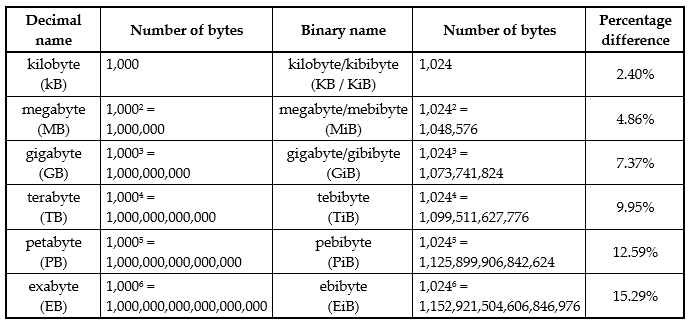Since I have a background in physics, errors in units are always slightly more likely to catch my eye during proofreading. It occurred to me while proofreading an ICT document that the unit of memory ‘kilobyte’ is more or less the only unit in the world that people commonly abbreviate with an upper-case ‘K’ to denote the ‘kilo-‘ prefix (every other unit adopts the lower-case ‘k’: km, kg, kW, ktoe…). So I began to wonder – is ‘KB’ one of those mistakes that is so common that people stop noticing?
As it turns out, both ‘kB’ and ‘KB’ are acceptable – but they both mean different things.
No doubt the especially ICT-literate among us have always known the difference, but many more have probably been assigning one rule or the other without even realising the full implication. To summarise:
1 kB = 1,000 bytes, following the decimal convention shared with other units.
1 KB = 1,024 bytes, following the binary system of numbers that lends itself more easily to computing (1,024 = 2^10).
So in fact, 1 kB and 1 KB are fundamentally different quantities of memory. Not only this, but as the size of units increases, the disparity widens. One decimal megabyte, for instance, is 1,000 × 1,000 = 1,000,000 bytes. But a binary megabyte is 1,024 × 1,024 = 1,048,576 bytes!
Essentially, the disparity widens with each increase in unit size, to the point where it becomes really quite significant:
As you can see, in recent times separate binary names (and the unit notation KiB rather than KB) has been introduced to reduce confusion among those working in computing. By the time exabyte/ebibyte levels are reached, the difference in capacity is some 15%!
So when should each be used? Well, typically the decimal (kB) convention is used for data transfer speeds, bus speeds, and the majority of storage media, while the binary (KB or KiB) convention is used for random access memory. This may not always be true though – reportedly, Apple have taken advantage of the disparity in the past to use decimal to make their products appear faster than Microsoft equivalents, despite the real values being identical!
In conclusion, something extra to look out for next time you come across it in proofreading work? Or largely irrelevant? It is likely to depend on how technical the document is that you’re working on. But it’s useful to know that something that may not even have occurred to most of us really does make a difference.
Share this post:
Follow us:




Leave a Reply
You must be logged in to post a comment.